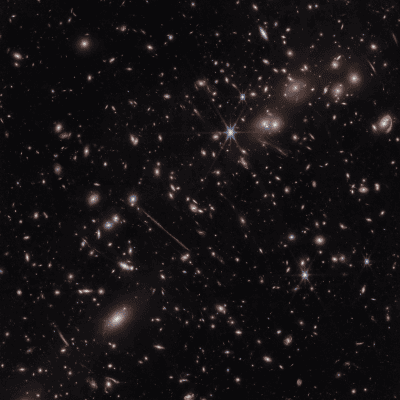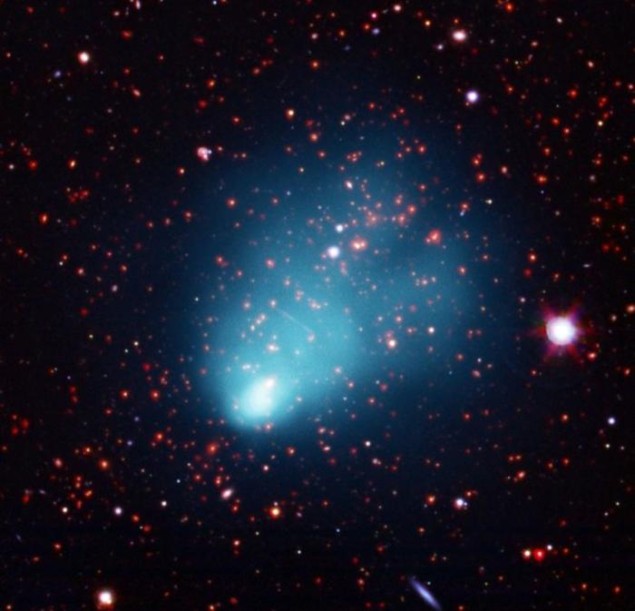
The existence of a massive galaxy cluster known as El Gordo is not compatible with standard theories of cosmology, say astrophysicists in the UK and Germany. Based on recent Hubble Space Telescope observations and their own simulations, the researchers claim that the cluster’s formation would be better described by an alternative theory of gravity known as Modified Newtonian Dynamics, or MOND.
In standard theories of cosmology, galactic clusters form at the nodes of filaments of dark matter within the cosmic web. This formation mechanism implies that they should all grow at approximately the same average rate as matter falls into the nodes. El Gordo, however, is unusually massive for its age. The latest Hubble Space Telescope observations used weak gravitational lensing to pin its mass at 2.13 × 1015 solar masses, but its redshift is just 0.87, and we see it as it existed 6.2 billion years ago – around a billion years after it formed from the merger of two smaller clusters.
The new simulations suggest that to replicate El Gordo’s observed morphology, temperature and X-ray luminosity, these smaller clusters – which should, according to standard theories, be filled with dark matter – must have collided with a velocity of at least 2500 kilometres per second. This is faster than gravitational models of dark matter can explain, leaving the authors of the latest research questioning the role of this still-mysterious substance in the standard model of cosmology, which cosmologists call ΛCDM or LCDM (where Λ or L refer to dark energy, and CDM stands for cold dark matter).
“Considering the wide range of prior simulations that tried to replicate El Gordo with a slower collision but found that it does not really look realistic, I would argue that it cannot really work in LCDM,” says Indranil Banik, a research fellow at the University of St Andrews and a co-author (with Elena Asencio and Pavel Kroupa of the University of Bonn) of a paper in The Astrophysical Journal on the new simulations.
A tension with standard cosmology
This is not the first time that Asencio, Banik and Kroupa have found incompatibilities between El Gordo and LCDM. In 2021, they described a model based on an earlier mass estimate for the cluster as a “massive blow” to LCDM. They also note that El Gordo is not the only cluster that has come under scrutiny for a potential conflict with LCDM.
“There are definitely other clusters that have already been observed and which also show some tension with LCDM,” Asencio tells Physics World. Examples include the Bullet Cluster and Abell 1758, which is 3.2 billion light-years away and has a total mass of 3.3 × 1015 solar masses.
Different points of view
In truth, while the trio describe their results as in “tension” with LCDM, they are actually arguing that dark matter does not exist, and that MOND should replace it as the basis of a new, alternative cosmology to LCDM. Douglas Clowe of Ohio University in the US is among those who doubt the evidence is strong enough to require such a significant shift, and he thinks the new results could have a simpler explanation.

“The systematic error in infall velocity measurements are often quite high and frequently explain such results,” he says. Clowe’s own analyses of both the Bullet Cluster and Abell 1758 concluded that whatever is producing the anomalous extra gravity is displaced from the clusters’ visible matter and their intra-cluster plasma. The logical inference, he says, is that unseen dark matter, and not a modification to the gravitational force of visible matter, must be the culprit.
Richard Massey of Durham University, UK, agrees that anomalies in observations of the Bullet Cluster have been resolved in favour of dark matter. “The ‘tension’ there just tuned out to be a different point of view from the people who had taken the images to those who interpreted it,” he says.
This “different point of view” is often at the heart of the debate between proponents of dark matter and of MOND. For Massey, the key to resolving it will be to develop a more joined-up approach, one in which the scientists running the telescopes and those running the supercomputer simulations that model what the telescopes might see work together to interpret complex data.
“This team is trying to act as interlocutors between groups, but aren’t directly involved in any of the aspects of data collection, analysis or interpretation,” says Massey. “They have helpfully started a dialogue, but I’d like to see a more joined-up analysis before I put a great deal of trust in the conclusions.”
A cluster too soon?
For their part, Asencio, Banik and Kroupa say the very existence of El Gordo during this era of cosmic history is evidence that something is amiss. “The El Gordo cluster having formed and already collided by a redshift of 0.87 shows that the universe forms structure far more rapidly and efficiently than predicted by LCDM,” Kroupa tells Physics World.

Galactic ‘bridges’ could be the largest rotating structures ever discovered
Kroupa doesn’t pull his punches. For him, clusters such as El Gordo are convincing evidence that dark matter is a fantasy, one that could have far-reaching repercussions. “Such galaxy cluster collisions are in complete disagreement with LCDM while being in rather natural agreement with the MOND cosmological calculations done until now,” he says. “We need to develop a new, realistic cosmological model – we are talking about a paradigm shift that happens in science only once every 100 to 200 years.”



